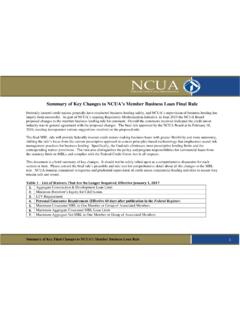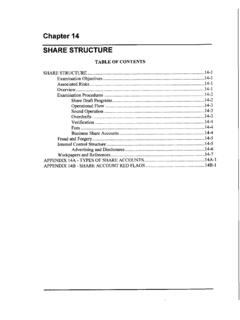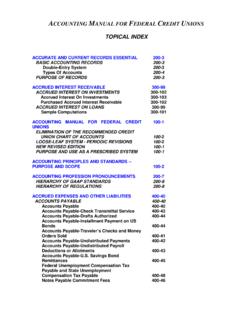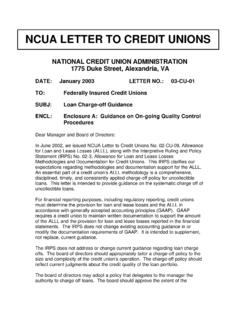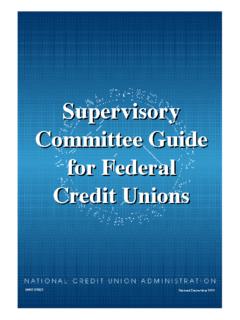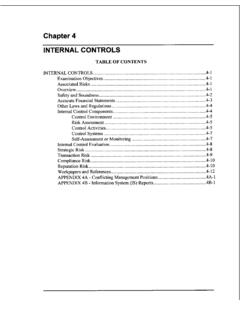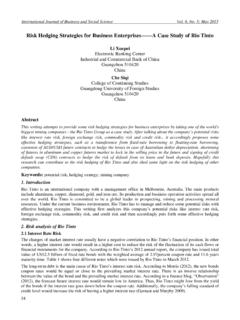Transcription of Chapter 12 Investment Analysis - NCUA
1 Chapter 12 Investment Analysis TABLE OF CONTENTS Investment Analysis ..12-3 Examination Objectives ..12-3 Associated risks ..12-3 Overview ..12-3 Examiner Resources ..12-4 Policies ..12-4 Examination Guidance ..12-10 Classification of Securities SFAS 115 ..12-10 Broker-Dealer Analysis ..12-11 Audit ..12-14 Safekeeping ..12-14 Records ..12-17 Investment Valuation ..12-18 Bond Basics ..12-18 Principal ..12-19 Coupon Day Count Basis ..12-20 Accrued Interest ..12-20 Price Quotations ..12-20 Yield Quotations ..12-21 Investment Products ..12-22 US Treasury Securities ..12-22 Treasury Bills ..12-22 Treasury Notes and Bonds ..12-23 Treasury Zeros or STRIPS ..12-23 Other US Guaranteed Securities ..12-24 Federal Agency Securities ..12-24 Government Corporations ..12-24 Government Sponsored Enterprises ..12-25 Obligations ..12-26 Secondary Participations.
2 12-27 GNMAs ..12-28 SBA Guaranteed Loans ..12-31 Zero Coupon Bonds ..12-31 SMBS ..12-32 IOs and POs ..12-32 CMOs ..12-35 Investment Analysis REMIC ..12-37 IRPS 98-02 ..12-37 Divestiture of Securities ..12-40 Residual Interests ..12-41 Fair Values ..12-41 Investment in Mortgage Notes ..12-42 Mutual Funds, Common Trusts, Unit Trusts ..12-42 Legality of Fund ..12-43 Characteristics and risks ..12-43 Fees ..12-44 Unit Investment Trusts ..12-44 CUSOs ..12-45 Federal Funds ..12-45 Credit Risk ..12-46 Corporate Credit Unions ..12-46 Other Credit Unions ..12-47 Other Shares, Deposits, and Certificates ..12-47 Thrift Shares and Bank Deposits ..12-47 Time Certificates of Deposit ..12-48 Deposit Notes ..12-52 Bank Notes ..12-52 Eurodollar Deposits ..12-53 Yankee Deposits ..12-53 Bankers Acceptances ..12-53 Mutual Savings Banks, State Banks, Trust Companies ..12-53 Loans to Other Credit Unions.
3 12-54 State and Municipal Obligations ..12-54 Repurchase Commitments to Purchase or Sell Securities ..12-55 Standby Commitment ..12-55 Cash Forward Agreement ..12-56 Short Sale ..12-56 Pair -Off Transactions ..12-56 Reverse Repurchase Transactions ..12-56 Adjusted Trading ..12-58 Impermissible or Unsuitable Investments ..12-59 Investment Trading ..12-60 Workpapers and References ..12-61 GLOSSARY OF Investment TERMS - APPENDIX 12A ..12-63 REVIEWING THE AUDIT OF DERIVATIVE INSTRUMENTS, HEDGING ACTIVITIES, AND INVESTMENTS IN SECURITIES APPENDIX Overview ..12-99 References ..12-104 Investment Analysis 12-3 Chapter 12 Investment Analysis Determine adequacy of the credit union s Investment policy, procedures, and internal controls Assess legality of investments and compliance with related regulations, accounting procedures, and other guidelines Evaluate suitability of the Investment portfolio in relation to the credit union s business plan, asset-liability management (ALM)
4 Strategies, liquidity, and net worth position Determine fair value of the Investment portfolio and the effect of realized or potential losses from Investment transactions on the credit union s earnings and capital position Review correction of Investment -related problems by management The Investment area affects all seven risks found in credit union operations credit, interest rate, liquidity, transaction, compliance, strategic, and reputation. (The Risk-Focused Program Chapter contains a description of the seven risks faced by credit unions.) This Chapter specifically addresses credit, interest rate, liquidity, transaction, compliance, and other operational risks ; however, if credit unions suffer significant losses due to Investment decisions, the credit union could also face reputation risk. Examiner s judgment plays an important role in identifying both the type and extent of risks as well as deciding on appropriate examination procedures.
5 The Investment portfolio serves as an important source of liquidity and can represent a substantial portion of a credit union s assets. Likewise, Investment income can serve as an important source for meeting a credit union s operating expenses, dividend payments, and reserve requirements (if applicable.) Thus, the examiner s assessment of management s ability to invest prudently is an important part of the examination. The extent of the examiners Investment reviews will depend on the following: The results of reviews of Investment policies, procedures, practices, and internal controls; The adequacy of management s risk monitoring system for investments; The condition of Investment records; The volume and materiality of Investment transactions; and Examination Objectives Associated risks Overview Investment Analysis 12-4 The degree of problems disclosed by previous audits or examinations.
6 Examiners record the extent of the Investment Analysis (if they perform such an Analysis ) in the Scope Workbook. They should also complete applicable Investment questionnaires or reports. The key Investment references for this Chapter are ncua Rules and Regulations 703, IRPS 98-02, and related Guidance Papers. Other resources that may assist examiners in their Analysis of complex Investment portfolios include: Regional capital market specialists (RCMS) in each regional office provide technical assistance; Bloomberg terminal, an information vendor system available through each RCMS, provides Investment characteristics and Analysis ; Office of Strategic Program Support and Planning (OSPSP) in the Central Office provides additional assistance (examiners should follow regional procedures); The ncua Investment Hotline (1-800-755-5999) provides examiners and credit unions a resource to call and discuss Investment questions.
7 The board of directors must (1) adopt a written Investment policy consistent with the Federal Credit Union Act, ncua Rules and Regulations, and other applicable laws; and (2) review and update the Investment policy at least annually. A monitoring and reporting program helps ensure the credit union s Investment process adheres to the written policy. If the Investment review discloses exceptions to sound Investment policies or procedures, the examiner will recommend appropriate changes to resolve the concerns. The credit union's size and asset mix determine the scope of the Investment policy. At a minimum, the policy must address the following: Purpose and objectives. The credit union must document its intentions (purpose) at the time it purchases Investment securities, and must classify each security as one of the following: held-to-maturity, available-for-sale, or trading.
8 SFAS 115 contains additional guidance. Investment objectives should reflect the relative importance of investments to the credit union's overall goals and objectives. Generally, credit unions attempt to balance the need for safety and liquidity against the need for yield, while maintaining enough flexibility to respond to rapid changes in market interest rates. Thus, Investment Examiner Resources Policies Investment Analysis 12-5 objectives should closely coincide with internal asset-liability goals and the short- and long-term business plan. Characteristics of investments. Investment characteristics describe the permissible investments and explain their pros and cons. The board of directors must specify in the Investment policy the types and characteristics of investments permitted for the credit union. Characteristics may include the issuer, maturity, coupon rate, index, cap, floor, coupon formula, call provisions, average life, and interest rate risk ( , duration.)
9 For example, a board policy specifying permissible interest rate risk (IRR) of an Investment communicates to management the board s tolerance for risk at the instrument level. The policy should ensure management considers the effect of Investment characteristics on the marketability and resale value of the Investment and the credit union s ability to achieve established liquidity objectives. IRR. IRR is the potential for change in the value of a security as market interest rates change (also referred to as market risk.) Changes in interest rates can reduce the Investment s value. Managing IRR on a total balance sheet basis, which includes monitoring the price sensitivity of the Investment portfolio and long-term loans, is a sound business practice. A credit union may consider whether it should specify institution-wide IRR limits (generally for net economic value or earnings exposures) in light of its long-term Investment and lending activities and its level of capital.
10 Credit unions, especially those that do not establish institution-wid e IRR limits, may choose to establish price sensitivity limits on their Investment portfolio or individual investments. The officials must understand that, while many investments have good marketability, the selling price of an Investment may be sensitive to changes in interest rates. For example, although Treasury securities usually have ready marketability, longer-term fixed-rate Treasury securities generally will experience greater price volatility than shorter-term fixed-rate Treasury securities. Management must prepare a risk report at least quarterly if the fair value of all securities with (1) embedded options, (2) maturities greater than three years, or (3) complex coupon formulas exceeding net capital. The risk report must document potential effects of interest rate shifts of plus and minus three percent (300 basis points) on each security s fair value and the cumulative effect of those shifts on capital ( ) Liquidity risk.
